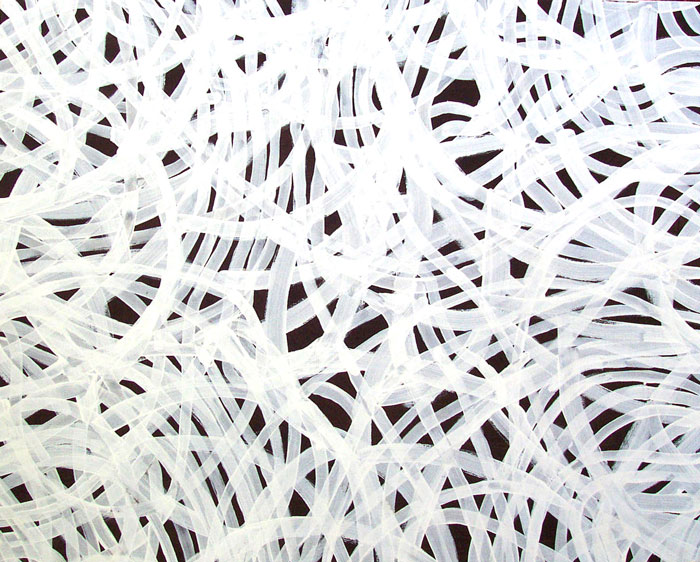Emily Kame Kngwarreye - Yam
ADG: 0572
DescriptionYam - Story of painting
The growth pattern of the wild yam, was a recurring element in the works of Emily Kame Kngwarreye. Emily’s middle name Kame is taken from the yam dreaming site at Alhalkere.
Emily’s yam story can be found in the energetic marks of her paintings as an underlying grid. The flowing lines represent the growth pattern of the yams lying under the desert earth.
Emily KAME KNGWARREYE - Biography
c. 1910 – 1996
Language Eastern Anmatyerre/ Alyawarr
Country Alhalkere, Soakage Bore/Boundary Bore, Utopia, NT
Medium Printmaking, batik silk and cotton, painting- acrylic on linen, canvas or paper
Stories Awelye (women's dreaming); Arlatyeye (pencil yam); Arnkerrthe (mountain devil lizard); Ntange (grass seed); Tingu (a dream time dingo pup); Ankerre (emu); Intekwe (a favourite food of emus - a small plant); Atnwerle (green bean) Kame; Atneltyeye country; Alhalkere country.
Emily is recognised, worldwide, as one of Australia’s most significant artists in the late 20th Century. Her paintings have influenced a change in the direction of Australian Aboriginal art from the use of traditional iconography to an open abstract landscape. Emily was born at Ahalkere in the Utopia Homelands, and was the adopted daughter of Jacob Jones, an important Law man. She learnt ancestral stories, song cycles, traditional body paint secret- sacred markings for women’s dancing ceremonies, and became a leader in women’s ceremonial business. Working as a stockhand, she became very familiar with the Utopia landscape, and her paintings are maps of her traditional lands. A bold, forceful and strong woman, her paintings, with their immediacy and strong, definite and sure lines painted the Utopia of her ancestors in the last ten years of her life. Emily painted the abstract markings of ceremonies and the landforms of her country of Alhalkere with its distinctive arched rock formation. Emily painted the “whole lot”, celebrating her country in Utopia.
Awards
1993 Australian Government Creative Fellowship
Selected Collections
Araluen Arts Centre, Alice Springs
Artbank, Sydney
Art Gallery of South Australia, Adelaide
Art Gallery of New South Wales, Sydney
Art Gallery of Western Australia, Perth
Auckland City Art Gallery, Auckland, New Zealand
Benalla Art Gallery, Benalla, Victoria
Buckingham Palace, London
Coventry Collection, Sydney
Donald Kahn Collection, Lowe Art Museum, University of Miami
Flinders University Art Museum, Adelaide
Gantner Myer Collection
Kelton Foundation, Los Angeles
Kluge-Ruhe Aboriginal Art Collection, University of Virginia Art Museum, USA
Museum of Victoria, Melbourne
National Gallery of Australia, Canberra
National Gallery of Victoria, Melbourne
Queensland Art Gallery, Brisbane
Riddoch Art Gallery, Mount Gambier, South Australia
The Holmes a Court Collection, Perth
The Kelton Foundation, Santa Monica, USA
The Vatican, Rome
University of New South Wales, Sydney
University of Sydney Union, Sydney
Solo Exhibitions
1990 First Solo Exhibition, Utopia Art Sydney
1990 Gallery Gabrielle Pizzi, Melbourne
1990 Coventry Gallery, Sydney
1991 Emily Kame Kngwarreye, Utopia Art Sydney, Stanmore
1991 Gallery Gabrielle Pizzi, Melbourne
1992 Alkalhere, Utopia Art Sydney, Stanmore
1992 Gallery Gabrielle Pizzi, Melbourne
1993 Recent Paintings by Emily Kame Kngwarreye, Gallery Gabrielle Pizzi, Melbourne
1994 Emily Kame Kngwarreye, New Directions, Utopia Art Sydney
1994 Emily Kame Kngwarreye, Utopia, Rebecca Hossack, London
1997 Represented Australia in the Venice Biennale, Italy
1998 Emily Kame Kngwarreye - Alhalkere. Queensland Art Gallery, Brisbane
1999 Emily Kame Kngwarreye: a celebration. Aboriginal Dreamings Gallery, Canberra
2008 Utopia: The Genius of Emily Kame Kngwarreye, Osaka, Tokyo, Canberra
Artist Ranking - Most Important Australian Indigenous Artists (Living and Deceased)
2011 No.1/100 Emily Kame Kngwarreye

